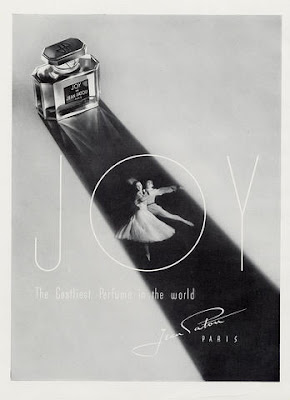I first started paying attention to perfume advertisement in the 1980s. Already loving perfume because it was a feminine and mysterious way of self-expression, I became aware of the fantasy aspect and the alluring promises on the glossy pages of the magazines. But I wasn't very impressed with the slogan for Joy by Jean Patou: "The costliest perfume in the world". Yes, it was the 80s, the era of Blake Carrington, but I still thought it was not a very tasteful way to promote oneself (attn.: Clive Christian). What I didn't know until reading about in Michal Edwards' book, Perfume Legends, was that the tag line came long before the Decade of Greed. It was Jean Patou's friend and publicist Elsa Maxwell who came up with it in 1930.
I was quite indifferent to Joy for most of my perfumed life. It was too floral, especially too rosy. The EDT version was decidedly aldehydic and I much preferred Chanel No.5 for this sort of thing. It's only in the last decade that I caught up with the magic when my interests got me into the rabbit hole of vintage perfume. Once Procter & Gamble swallowed Jean Patou and made it part of their detergent and toothpaste empire (they sold it since. More on that later), Joy was no longer Joy and I'm willing to bet a vintage bottle or two that it was no longer all that costly to make. I smelled that stuff. I remember.
But vintage Joy was a different creature. I learned to appreciate the way the different concentrations emphasized certain facets. The parfum was and is still my favorite. It's sweeter on my skin, and I can finally get glimpses of more white flowers in there, from an exceptionally delicate tuberose, a heady muguet to an addictive (and joyful) honeysuckle. Generally I can say that the sweeter Joy becomes the better I like it. It's not a scientific statement or anything, but to me the height of Joy is when it smells more like nectar than petals or pollen. But that's just me.
I've collected several bottles of Joy from different years and have had samples sent by friends who also collect vintage fragrance. I don't know enough to date them, but it's fascinating to smell the subtle and not so subtle differences between the versions. Some are milky-creamy, others have a bolder rose note that smells practically pink. One sample was wonderfully animalic- the sort of alchemy that happens when indolic jasmine meets civet. Another ended up smelling too powdery on my skin and the rose disintegrated and became a bit too sour for my taste.
The dry-down is exceptional, though, in just about any Joy bottle I've met. It's long-lasting (unlike the P&G dreck) and surprisingly warm. The rose is round and makes me think of the colors of vintage sentimental greeting cards. The fragrance responds to body heat and that's what makes it sexier in the end of the day-- Joy is far less prissy than I ever expected, and far more plush and lush.
Joy has been reformulated too many times to keep track. My one and only recommendation is to use your nose and not buy the bottles that bear the P&G Prestige. The conglomerate sold Jean Patou two years ago. The buyer, Designer Parfums, has been working for a while on restoring the perfumes to a more recognizable(though IFRA compliant) form. New bottles of Joy, 1000 and Sublime started arriving at select department stores late last year. I have yet to actually try them, so please comment if you had. Did you buy a bottle? What is your favorite version of Joy?
Vintage Joy de Jean Patou ads (1938, 1946, 1947, 1957, 1965, 1986) via hprints.com.
COPYRIGHT ©2006-2012 GAIA FISHLER WWW.THENONBLONDE.COM, ALL RIGHTS RESERVED.
CONTENT POACHING IS BOTH ILLEGAL AND UGLY.
Copier, C'est Voler.





